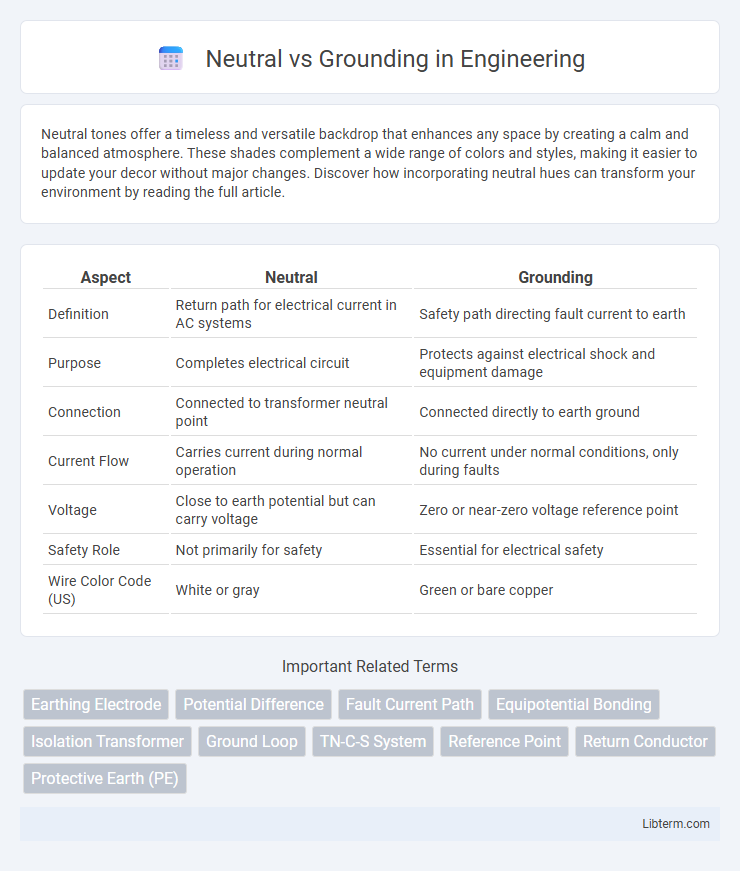Neutral tones offer a timeless and versatile backdrop that enhances any space by creating a calm and balanced atmosphere. These shades complement a wide range of colors and styles, making it easier to update your decor without major changes. Discover how incorporating neutral hues can transform your environment by reading the full article.
Table of Comparison
| Aspect | Neutral | Grounding |
|---|---|---|
| Definition | Return path for electrical current in AC systems | Safety path directing fault current to earth |
| Purpose | Completes electrical circuit | Protects against electrical shock and equipment damage |
| Connection | Connected to transformer neutral point | Connected directly to earth ground |
| Current Flow | Carries current during normal operation | No current under normal conditions, only during faults |
| Voltage | Close to earth potential but can carry voltage | Zero or near-zero voltage reference point |
| Safety Role | Not primarily for safety | Essential for electrical safety |
| Wire Color Code (US) | White or gray | Green or bare copper |
Understanding Electrical Concepts: Neutral vs Grounding
Neutral and grounding serve distinct roles in electrical systems to ensure safety and functionality. The neutral wire acts as the return path for current in an electrical circuit, carrying current back to the power source, while the grounding wire provides a safe path for fault currents to disperse into the earth, preventing electrical shocks. Understanding the difference is crucial for electrical safety, as neutral is part of the current-carrying circuit, whereas grounding is primarily a protective measure.
The Role of Neutral in Electrical Systems
The neutral wire in electrical systems serves as a return path for current, ensuring the stable operation of electrical circuits by maintaining voltage balance and preventing overloads. It carries current under normal operating conditions and is essential for completing the electrical circuit and enabling the flow of electricity. Proper connection and maintenance of the neutral wire are crucial to enhance safety, prevent electrical shocks, and protect equipment from damage.
Grounding: Definition and Purpose
Grounding refers to the process of connecting an electrical system or device to the earth to provide a safe path for excess electrical energy, preventing electric shock and protecting equipment from damage. It establishes a reference point for voltages in the system, ensuring stable operation and reducing the risk of electrical faults. Effective grounding is essential for electrical safety, system reliability, and the prevention of power surges or electrical fires.
Key Differences Between Neutral and Grounding
Neutral and grounding serve different functions in electrical systems; neutral acts as a return path for electric current in AC circuits, while grounding provides a safety path for fault currents to prevent electric shock. The neutral conductor is connected to the system's midpoint, typically bonded to earth at the main panel, whereas grounding involves a direct physical connection to the earth via grounding rods or plates. Key distinctions include neutral carrying current during normal operation and grounding remaining non-current carrying except during fault conditions, which enhances electrical safety and system stability.
Importance of Proper Neutral Connections
Proper neutral connections ensure electrical system safety by providing a clear return path for current and preventing voltage imbalances. Inaccurate or loose neutral wiring can cause equipment malfunctions, electrical shocks, or fire hazards due to unintended current flow. Grounding stabilizes voltage levels and protects against electrical faults, but only a correctly connected neutral maintains system integrity and reliable operation.
Safety Benefits of Grounding Systems
Grounding systems provide critical safety benefits by directing fault currents safely into the earth, minimizing the risk of electric shock and equipment damage. Unlike neutrals, which carry current during normal operation, grounding conductors activate only during fault conditions, ensuring effective protection without interrupting regular circuit function. Properly designed grounding reduces electrical hazards, prevents fire risks, and enhances overall system reliability in residential, commercial, and industrial installations.
Common Misconceptions: Neutral vs Ground
Neutral and ground are often mistakenly considered identical, but they serve distinct roles in electrical systems; the neutral carries current back to the source under normal operation, while the ground provides a safety path for fault currents. Misconceptions arise when the neutral is incorrectly used as a grounding conductor, potentially leading to electrical shock hazards and equipment damage. Proper differentiation and connection of neutral and ground wires are essential for electrical safety and code compliance in residential and commercial wiring.
Electrical Code Requirements for Neutral and Ground
The National Electrical Code (NEC) mandates that the neutral conductor carries current under normal operation, serving as the return path for electrical current, while the grounding conductor provides a safe path for fault current to prevent electric shock. Neutral and grounding conductors must be separated after the main service panel to avoid parallel paths that can cause electrical hazards and interference. NEC Article 250 specifies grounding electrode system requirements, whereas Article 200 details neutral conductor rules, ensuring proper bonding, conductor sizing, and installation to meet safety and functional criteria.
Consequences of Improper Grounding or Neutral Wiring
Improper grounding or neutral wiring can lead to severe electrical hazards including electric shock, equipment damage, and increased risk of fire due to unintentional current flow. Faulty neutral connections may cause voltage imbalances, resulting in malfunctioning appliances and potential overheating. Ensuring correct grounding and neutral wiring is critical for electrical system safety, preventing electrical faults and regulatory non-compliance.
Best Practices for Neutral and Grounding in Home Wiring
Proper separation of neutral and grounding conductors in home wiring reduces electrical noise and prevents potential shock hazards. Best practices include using the neutral conductor solely for return current paths while grounding wires connect all metallic parts to earth for safety. Ensuring the main electrical panel is the only point where neutral and ground are bonded maintains system integrity and compliance with NEC guidelines.
Neutral Infographic

 libterm.com
libterm.com